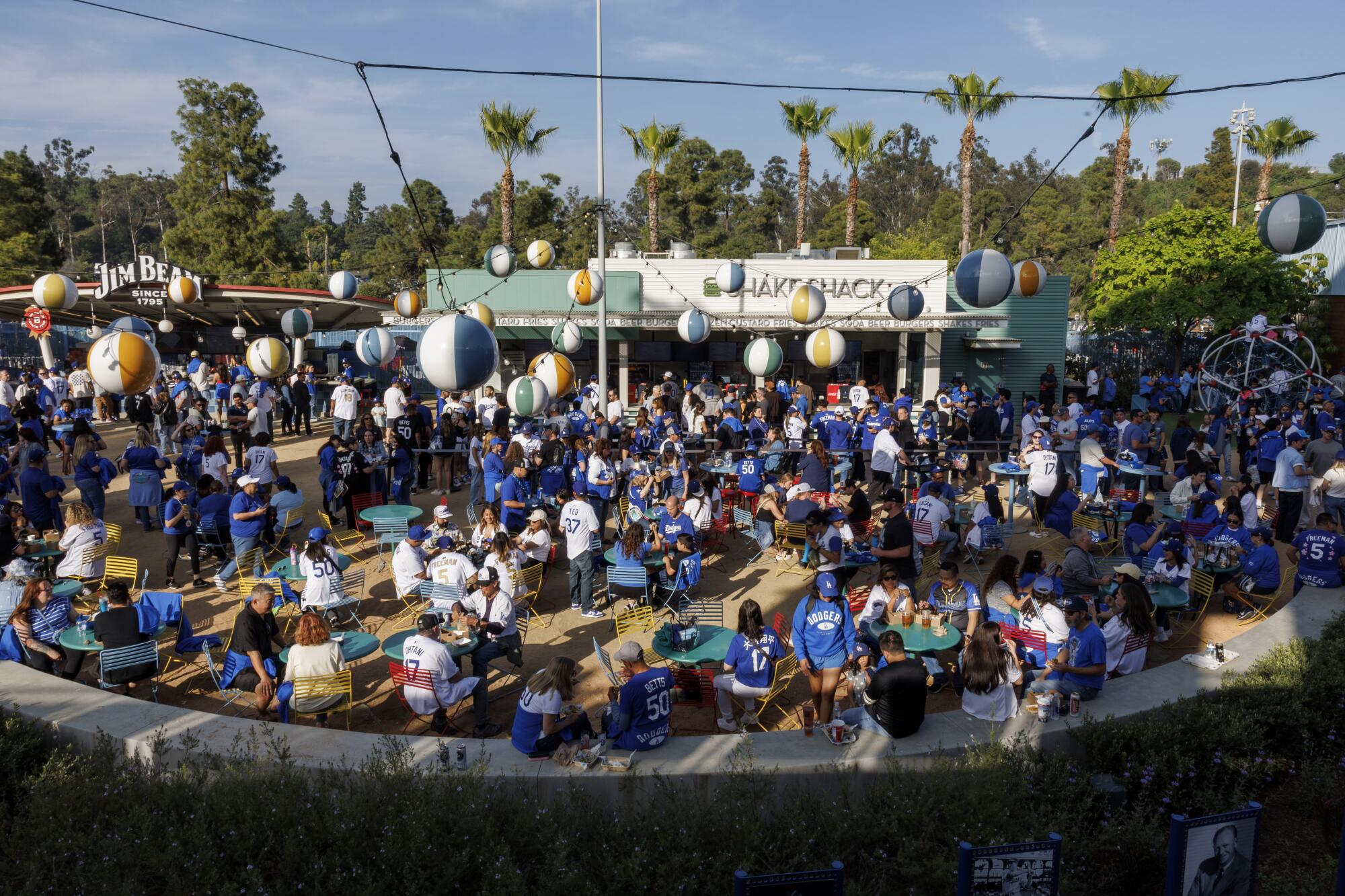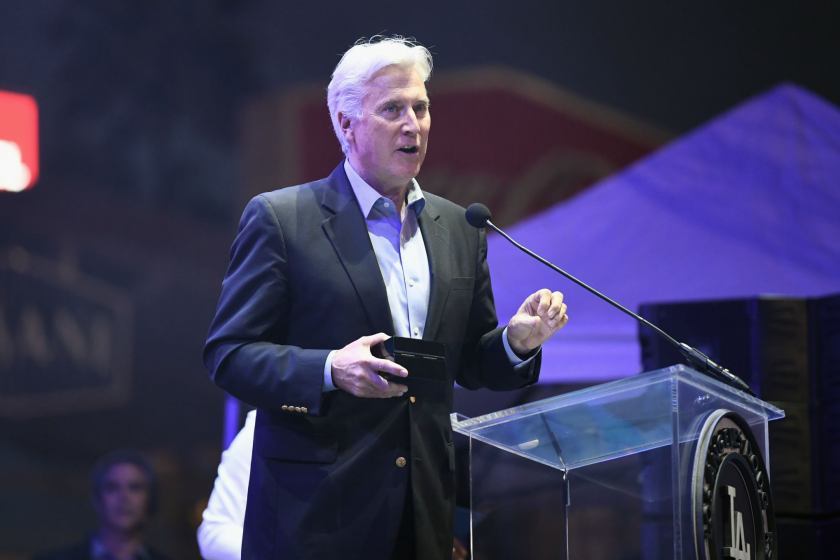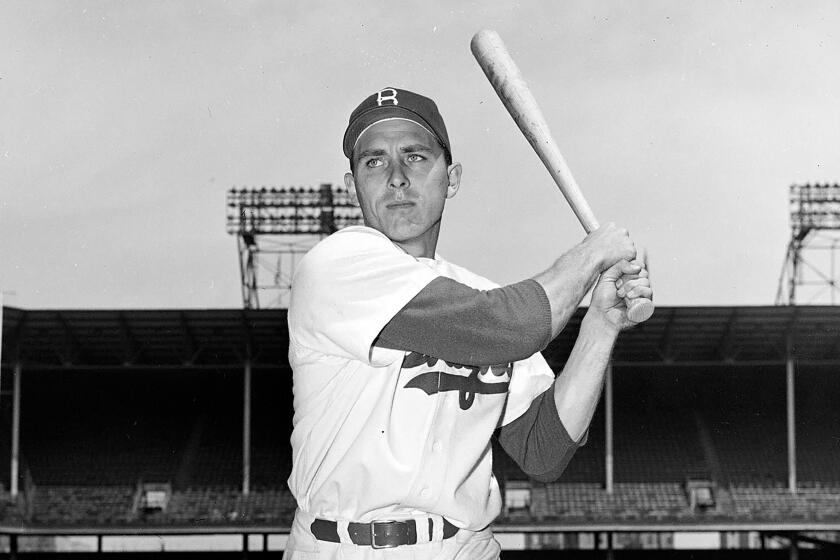
- Share via
The two New York teams dropped by Dodger Stadium a couple of weeks ago, first the Yankees and then the Mets, and broadcasters for each team made sure to complain about how loud it was.
“The Dodger Stadium center field speakers are in full assault mode,” Yankees radio voice Dave Sims tweeted.
On the ESPN Sunday night broadcast from Dodger Stadium that week, Karl Ravech introduced an in-game interview with the Dodgers’ Tommy Edman this way: “He’s in center field now, being blasted by, I think, arguably the loudest speaker system I have ever heard in my life.”
Notwithstanding the audacity of New Yorkers whining about someone else’s volume, the broadcasters did lend their distinguished voices to a long-running debate among Dodgers fans: Is it loud at Dodger Stadium, or is it too loud?

“It’s just all part of an entertainment show,” Mookie Betts said. “There is no ‘too loud.’”
Organists Helen Dell and Nancy Bea Hefley soothed generations of fans, but the traditional soundtrack to a Dodgers game has gone the way of $10 parking and outfield walls free of advertisements. The fan experience now includes a finely choreographed production at virtually every moment except when the ball is in play, and that includes recorded music, cranked up.
“We don’t make it louder just to make it louder,” said Lon Rosen, the Dodgers’ executive vice president and chief marketing officer. “It’s all part of what fits in the presentation.”
And the players, the ones whose performance determines whether the Dodgers win or lose, love the presentation.
Shohei Ohtani the pitcher, the Dodgers learned, isn’t as playful as Ohtani the hitter. He snarls. He barks. He’s emotional, even downright combative at times.
“I think it’s great,” Clayton Kershaw said. “Even on the road, I’d rather have that than quiet. St. Louis was just really quiet. It almost felt like golf at times.
“The louder, the more fun, the better. The Dodgers have the best sound system out there. So why not use it?”
Said former Dodgers closer Kenley Jansen: “When I used to come out to ‘California Love,’ that thing used to bang. The bass they have, you can feel that thing shake in your chest.”
Just how loud is it at the ballpark?
To find out, I downloaded a decibel meter and visited Southern California’s three major league ballparks during an eight-day span this month. At Dodger Stadium, I walked around the ballpark, and up and down to different levels, but the readings were relatively consistent no matter where someone might be sitting.
Bottom line: It’s pleasant at Angel Stadium, lively at Petco Park, booming at Dodger Stadium.
Caveat: Even with all other things equal, it always will be louder at Dodger Stadium. The Dodgers sell 50,000 tickets to a game more often than not; no other major league ballpark even holds 50,000.
At 60 and 30 minutes before game time, as fans settled into the ballpark, Angel Stadium and Petco Park registered in the 65-75 dB range, roughly the sound of a normal conversation on the low end and household appliances on the high end.
The decision to let Shohei Ohtani start in a win over the San Diego Padres came after months of close observation and feedback from the Dodgers star.
The introduction of the home team lineup registered in the 80-85 dB range at Angel Stadium, 85-90 dB at Petco Park, and 90-95 dB at Dodger Stadium, roughly the sound of a noisy restaurant at the low end and power tools on the high end.
The high-end levels would be hazardous if sustained throughout the evening, but sounds ebb and flow as the game does. (Decibel levels are measured logarithmically, so an increase of 10 dB means sound is heard 10 times louder and an increase of 20 dB means sound is heard 100 times louder.)
The highest levels at any stadium occur not when a voice pleads “Get loud!” or “Everybody clap your hands!” but organically, as the result of a big moment in the game.
My decibel meter hit 100 dB twice during my three test games: immediately after the Angels’ Travis d’Arnaud homered in Anaheim, and as the Dodgers’ Will Smith slid safely into home plate with the tying run at Dodger Stadium, as the opposing catcher tagged him but dropped the ball.
What distinguishes the Dodger Stadium experience is the hour or so before the game starts. The Angels offer music, spotlight fans on the video board, and “invite you to enjoy the hospitality of Angel Stadium.” The Dodgers impose a relentlessly loud pregame show, with hype guys and hype girls, pounding away well above the 65-75 dB levels in Anaheim and San Diego, with dB readings into the 80s.

The Dodgers’ pregame show attempts to force anticipation upon the audience, as if that is somehow necessary. It’s not. You’re about to see Shohei Ohtani!
There is always something happening before the game in the center field plaza: a band, product giveaways, Instagram-worthy photo opportunities, the live pregame broadcast for SportsNet LA. You can get hyped there, if you like. Or you can enjoy a conversation with your friends in your seats, instead of getting a headache before the game even starts.
Tyler Anderson, who pitches for the Angels now and used to pitch for the Dodgers, said he finds no fault in the traditional way of presenting the game, or in the Dodgers’ way.
“It’s like you’re trying to turn that venue into one of the best bars in town, where you just go to the bar and listen to loud music and people are having a good time,” Anderson said. “I think that’s the atmosphere they’re trying to create. It’s a fun atmosphere for the fans too.

“And then some places are more family-based. They’d rather have kids and older families, and young kids and grandkids coming to games. They probably have less of a party atmosphere and less of a bar kind of atmosphere.
“There is no right or wrong way.”
In his ESPN in-game interview, Edman called the Dodgers’ sound system both “absolutely absurd” and “great.”
I asked Edman about that seeming contradiction.
“That was one of the things that stuck out to me my first time playing here, just how loud the speakers are,” he said. “You can’t hear yourself think.”
He got used to it, and to how he need not be distracted because the sound shuts off “once the play actually starts.” He likes it now.
“It makes it more fun,” he said. “It’s like a big league game.”
The Dodgers’ game presentation is creative and compelling. And, instead of eliminating the beloved organ, the Dodgers include talented organist Dieter Ruehle as part of the show. Really, just tone down the pregame hour, and we’re good.
Singer and social media star Nezza posted on TikTok that she sang national anthem in Spanish at Dodger Stadium Saturday despite the team’s objections.
Rosen shrugged off the notion that the Dodgers should tone down anything. If fans did not enjoy the production, he wondered, why would they keep packing Dodger Stadium?
“It’s really not any louder than any other of the more popular stadiums,” Rosen said.
He might be onto something. Veteran baseball columnist Bob Klapisch reported that, during last month’s Yankees-Mets series at Yankee Stadium, “the decibel levels at the stadium routinely reached the mid-90s.”
That, Mr. Yankee Announcer, would be “full assault mode.”
More to Read
Are you a true-blue fan?
Get our Dodgers Dugout newsletter for insights, news and much more.
You may occasionally receive promotional content from the Los Angeles Times.














